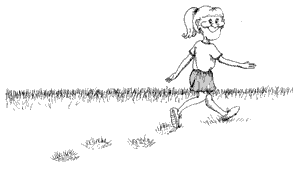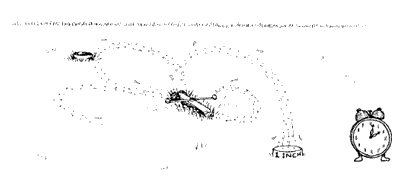Time of Year
Water leaves the soil from the soil surface down. Therefore the condition of both the soil and your lawn influences how frequently you need to water.
If You Have a Healthy Lawn--If your grass has good roots and your soil has a reasonable amount of organic matter, then you should not have to water in a normal spring or fall at all. After two weeks without rain during these seasons, look for signs that the grass may be thirsty. In the summer think about watering if you have not had a good rain (at least an inch) for over ten days to two weeks. Again, let your grass tell you when it is time.
If You Have a Poor Lawn--If your grass is in poor shape because your soil is compacted or poor, then be a bit more watchful. Typically such grass shows symptoms of thirst when rainfall is scarce within about 10 days in the spring or fall and within only a week in the summer. It may need extra watering as early as May in this situation. Until you improve the lawn you may have to water much more often than your neighbor who has a healthy lawn with a deep root system.
Recognizing Thirsty Grass
Water your lawn when it truly needs water--not before. Watering prematurely promotes shorter roots, disease-prone grass, insect-prone grass and wastes your time.
There are three ways your turf tells you it needs water:
Color Change -- When grass gets thirsty it changes color and texture. It wilts and acquires a subtle blueish tinge. The leaves or grass blades start to curl or fold in along their edges as their cells lose moisture and shrink. With experience you will be able to recognize these signs easily.
Soil Hardens -- Soil hardens as it dries out. So, if it resists the pressure of a screwdriver punched into the turf soil, that's a likely sign that it needs moisture. If the screwdriver penetrates the soil easily, then there is sufficient moisture there to support the grass.
 |
Footprints Tell a Story -- Normally, hydrated grass blades quickly return to their upright posture after being stepped on. However, blades lacking water remain prostrate for a period of time. Then it's time to water the lawn. Remember, grass mowed with a dull mower blade has brown tips. Do not mistake that as a sign of thirst. Just sharpen the mower blade.
Time of Day
Practically speaking, the best time of day to water a thirsty lawn is when you have time--morning, noon, or night. If your schedule allows, though, morning is really the best time to water. Then grass starts the day with plenty of moisture and foliage has lots of time to dry off before evening.
If you water in the heat of the day you waste water from evaporation. If you water during windy periods you also lose water to evaporation. If you water in the evening, the grass spends the night in a moist environment that may foster fungal disease.
Shade and Water Needs
Lawn areas under trees, even those with high canopies, are often neglected. Those shady areas often feel cool and comfortable as if there is plenty of soil moisture. In fact, grass plants in part shade need watering more often because they compete with nearby tree roots for soil moisture. Also, light rains often fail to penetrate thick tree foliage canopies and the soil below gets cheated of natural moisture. Consequently, shaded turf areas may need up to three times as much water as the rest of the lawn.
The idea is to provide enough water for both grass and trees to avoid inadvertently encouraging thirsty the tree roots to gravitate toward the surface of the soil to get water. Check shady lawn areas first because they will likely show drought stress first.
How Much to Water
When the soil does dry out and the grass is thirsty: water sufficiently. Because too much water bypasses the grass root zone and is wasted, and too little fails to reach the roots, this is easier said than done. Water generously enough so that the water soaks down into the soil--at least 4 to 6 inches. Understanding some watering basics helps determine how long that takes. Grass needs more water in the summer than in the spring. Grass growing in clay needs more moisture than grass in sandy soil. Grass in the shade under trees and shrubs needs more than grass in the sun.
Measure Watering in Inches - The easiest way to determine how much water to give a thirsty lawn is to use the "one inch rule". Using low maintenance standards, most northern lawns need about 1 inch of water a week during the spring and fall seasons in loam soils (more in clay, less in sand). When the weather is very hot and dry during the summer months, grass plants may need up to 2 inches of water a week in a loam soil (more in clay, less in sand). Note: while they might need two inches for the week, give grass only about one inch at a time, otherwise you are wasting water.
 |
Measure Watering in Time - Regardless of the type of sprinkler you use, simply set some empty cat food or tuna fish cans (about 1 inch deep) out in its watering pattern and time how long it takes for them to fill with water as it runs. Then estimate how long to run the system in the future to deliver an inch of water. For example, after you've determined that your particular sprinkler produces one inch of water in 54 minutes, then attach a mechanical timer to your system and water for 54 minutes in each area that needs it. To determine if the water has penetrated into the soil deeply enough, insert the probe of a houseplant water meter as deeply into the soil as needed. The meter will indicate if it is moist at that depth.

